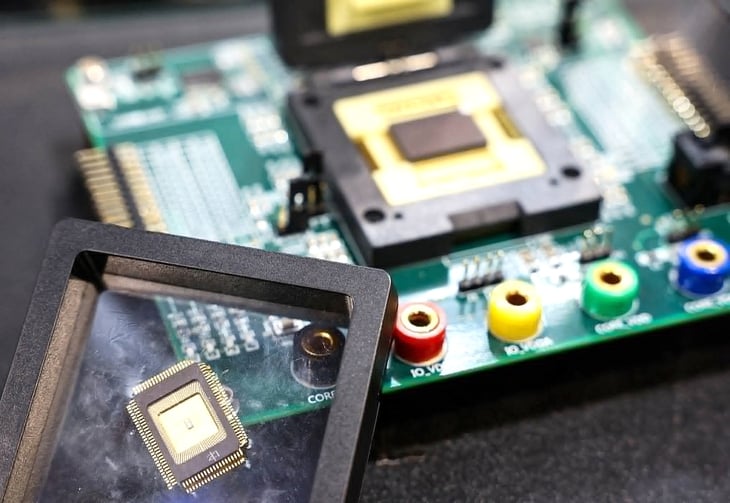
A semiconductor chip manufactured by TSMC is displayed at the Cybersec 2025 Conference and Exhibition in Taipei on April 15 - Photo: AFP
Washington's goal in continuing to tighten the ban on chip exports to China is not only to curb Beijing's ambition to lead in the field of artificial intelligence (AI), but also to accept the trade-off of the interests of American corporations to maintain the upper hand.
A blow to Nvidia
Considered one of the biggest victims of the US-China trade war, Nvidia Technology Corporation said on April 16 that it could suffer a loss of up to $5.5 billion in its first-quarter financial report, after the Washington government imposed new restrictions on AI chip exports to China - one of the company's most important markets.
Accordingly, the H20 chip - designed specifically for the Chinese market by Nvidia and subject to previous export control orders - will need a special license if it wants to continue selling to this country. Reuters news agency quoted Nvidia as saying that the new regulation will apply "indefinitely".
Immediately after the above information, Nvidia shares fell nearly 7% at the close of trading on the same day, causing the company's market value to evaporate more than 148 billion USD.
The sell-off in chip stocks quickly spread, with South Korean semiconductor companies Samsung Electronics and SK Hynix falling as much as 3% overnight in Asia.
In Europe, shares of ASML, a Dutch semiconductor giant, fell 5% in early morning trading after CEO Christophe Fouquet warned: "Recent tax announcements have increased uncertainty in the macroeconomic environment, and the situation will remain volatile for some time."
ASML also said orders in the first financial quarter were just 3.94 billion euros - about 1 billion euros lower than investor expectations.
Dan Ives, director of global technology research at Wedbush Securities, led a team of analysts in a note that while the specific financial impact is not too severe given Nvidia's overall scale, the new controls are a "strategic blow" that will severely complicate the company's efforts to maintain relationships with Chinese customers.
“New information suggests that Nvidia is facing significant hurdles in selling products to China, as the Trump administration appears to have realized that there is one company — and one chip — leading the AI revolution, and that is Nvidia,” the analysts wrote in a report published on April 15.
Michael Ashley Schulman, chief investment officer at Running Point Capital, agreed that the decision to restrict H20 chip exports reflects the growing geopolitical uncertainty that is looming over the technology and semiconductor sector.
"Especially under Trump-style reversal policies, this lack of certainty is unsettling for businesses and investment markets - as the sharp decline in Nvidia shares and the widespread pressure on chip stocks on the morning of April 16 clearly demonstrated," he said.
TSMC is the exception
As the semiconductor industry faces headwinds from geopolitical uncertainty and protectionism, TSMC appears to be a notable exception.
According to a financial report released on April 16, the Taiwanese chip giant achieved a net profit of NT$361.56 billion (about US$11.1 billion) in the first quarter of 2025, a remarkable growth of 60.3% over the same period last year.
TSMC is currently the main manufacturing partner for big names like Apple, AMD and Nvidia itself - meaning that while Nvidia is worried about being blocked from selling, TSMC is still manufacturing chips for Nvidia under orders from US companies or third parties.
TSMC's "neutral" status — neither a US company nor blacklisted in China — gives it the ability to serve both sides of the tech war.
Of course, that position doesn’t come naturally. According to the New York Times, TSMC is a central pillar of the global chip supply chain – an ecosystem built over more than 40 years with tens of billions of dollars in investment, thousands of highly skilled engineers and a network of partners spanning every continent.
In this cross-border collaboration model, US companies design the chips, TSMC manufactures them, Japan supplies the silicon wafers, the Netherlands supplies the lithography machines, and China and Malaysia are responsible for testing and assembly. Each link is tightly linked and not easily replaceable.
Lita Shon-Roy, managing director at chip materials consultancy Techcet, likens the chip supply chain to a multi-layered maze where materials can be refined in one country, blended in another and manufactured in a third.
With such a high degree of intertwining and interdependence, each step of imposing tariffs or export bans risks raising costs, disrupting supplies, and sending prices of consumer products — from smartphones and laptops to AI servers — soaring.
Therefore, although both the US and China are promoting the strategy of localizing chip production, this process is not easy. Recreating the technical human resources space, production management culture and global supply chain coordination capabilities cannot happen "overnight".
For China, the problem is even more complicated, as the country still relies heavily on Western technology. In the short term, Beijing’s exemption from tariffs on chip imports from Taiwan could be a way to buy time to prepare, maintaining the flow of technology to serve strategic areas such as AI, cloud computing and defense.
As for the US, if the ban continues to be tightened, companies like Nvidia could lose one of their biggest growth markets. But if the controls are loosened, the risk of technology falling into the hands of geopolitical rivals cannot be ignored.
This tug-of-war has turned semiconductors into one of the most complex knots in the current US-China relationship, where every policy decision has global consequences.
Source: https://tuoitre.vn/my-trung-giang-co-ve-chip-ban-dan-20250419063932389.htm


































































































Comment (0)